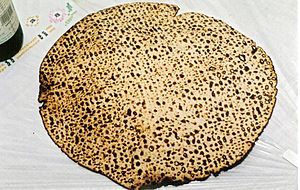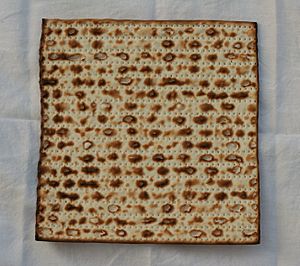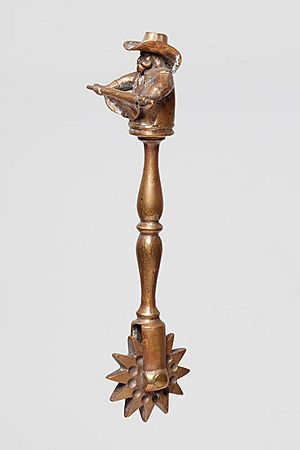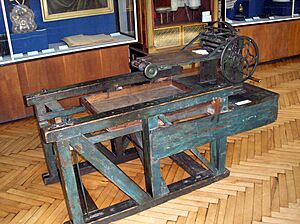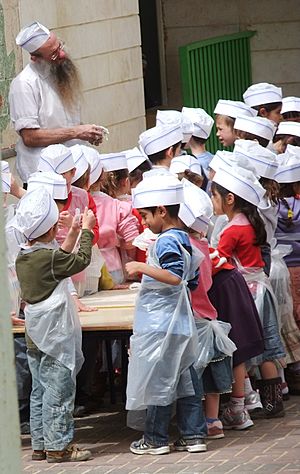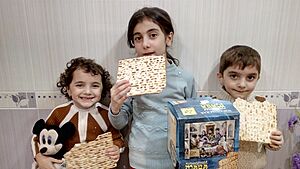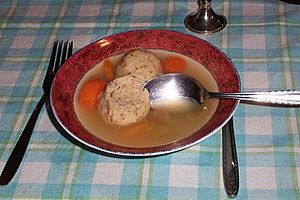Matzah facts for kids
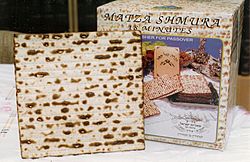
Machine-made matzot from Jerusalem
|
|
| Alternative names | Matzo, matza |
|---|---|
| Type | Flatbread |
Matzah (also spelled matzo) is a special kind of flatbread. It's a big part of Jewish cuisine and is very important during the Passover festival. During Passover, Jewish people do not eat chametz. Chametz is any food made from five specific grains (wheat, spelt, barley, rye, or oat) that has risen or fermented.
The Torah, which contains Jewish laws and teachings, says that the Israelites (who are now known as Jews and Samaritans) should only eat unleavened bread during the seven-day Passover festival. "Unleavened" means it's made without yeast or anything that makes bread rise.
Matzah can be soft, like a pita bread, or crispy, like a cracker. Most matzah you see in stores is the crispy kind because it lasts longer. When crispy matzah is ground into a flour-like powder, it's called matzah meal. This meal is used to make things like matzah balls for soup. Some Jewish communities, especially Sephardic Jews, prefer to cook with whole matzah instead of matzah meal.
For Passover, matzah must be "kosher." This means it follows Jewish dietary laws. In the Ashkenazi tradition, Passover matzah is usually just flour and water. The flour must come from one of the five special grains. Some Sephardic communities allow matzah to be made with eggs or fruit juice during the holiday.
Contents
Why is Matzah Important?
Matzah is mentioned many times in the Torah. It tells the story of the The Exodus from Egypt.
- "That night, they are to eat the meat, roasted in the fire; they are to eat it with matzo and maror." (Exodus 12:8)
- "From the evening of the fourteenth day of the first month until the evening of the twenty-first day, you are to eat matzo. " (Exodus 12:18)
- "You are not to eat any chametz with it; for seven days you are to eat with it matzo, the bread of affliction; for you came out of the land of Egypt in haste. Thus you will remember the day you left the land of Egypt as long as you live." (Deuteronomy 16:3)
- "For six days you are to eat matzo; on the seventh day there is to be a festive assembly for Hashem your God; do not do any kind of work." (Deuteronomy 16:8)
What Matzah Means
There are many reasons why matzah is so special.
A Symbol of Freedom
One main reason is historical. Passover celebrates the Israelites leaving Egypt. The Bible says they left so quickly that their bread dough didn't have time to rise. So, when they baked it, it became matzah. This reminds Jewish people of their quick escape to freedom.
A Reminder to Be Humble
Matzah is also called "poor man's bread." It reminds people to be humble and remember what life was like when they were not free. Leaven (what makes bread rise) can symbolize pride or corruption because it "puffs up." Eating matzah, the "bread of affliction," teaches humility and helps people appreciate their freedom even more.
A Sign of Hope
Matzah also reminds people of the traditional Passover offering made long ago. During the Passover Seder meal, the last piece of matzah eaten is called the afikoman. Many people see it as a symbol of future salvation and hope. The Seder meal is full of symbols of hope, including the famous closing line, "Next year in Jerusalem." Matzah is one of the oldest symbols of hope in the Seder.
What's in Matzah?
| Nutritional value per 100 g (3.5 oz) | |
|---|---|
| Energy | 1,653 kJ (395 kcal) |
|
83.70 g
|
|
|
1.40 g
|
|
|
Protein
|
10.00 g
|
| Vitamins | Quantity
%DV†
|
| Vitamin A | 0 IU |
| Thiamine (B1) |
34%
0.387 mg |
| Riboflavin (B2) |
24%
0.291 mg |
| Niacin (B3) |
24%
3.892 mg |
| Pantothenic acid (B5) |
9%
0.443 mg |
| Vitamin B6 |
9%
0.115 mg |
| Folate (B9) |
4%
17.1 μg |
| Minerals | Quantity
%DV†
|
| Calcium |
1%
13 mg |
| Iron |
24%
3.16 mg |
| Magnesium |
7%
25 mg |
| Manganese |
31%
0.650 mg |
| Phosphorus |
13%
89 mg |
| Potassium |
4%
112 mg |
| Sodium |
0%
0 mg |
| Zinc |
7%
0.68 mg |
| Other constituents | Quantity |
| Water | 4.30 g |
|
(Values are for matzo made with enriched flour)
|
|
| †Percentages estimated using US recommendations for adults. | |
For the Passover Seder, the most important matzah is usually made only from flour and water. The flour must come from one of the five special grains: wheat, barley, spelt, rye, or oat.
In Ashkenazi tradition, matzah made with things like wine, fruit juice, onion, or garlic is generally not eaten during Passover. However, older people or those who are unwell might be allowed to eat it.
Matzah made for other times of the year (not Passover) can have different ingredients like onion, garlic, or poppy seeds. It can even be made from other flours like rice or maize, which are never used for Passover matzah.
Gluten-Free Matzah
Some companies make matzah-like products that are gluten-free. These are made from things like potato starch or tapioca instead of the usual grains. They are for people who can't eat gluten, like those with coeliac disease.
Jewish religious leaders say these gluten-free products can be eaten on Passover. However, they don't fulfill the special commandment (mitzvah) of eating matzah at the Seder. This is because matzah for the Seder must be made from one of the five traditional grains.
Oat is the only one of the five grains that doesn't naturally contain gluten. So, some matzah makers now produce gluten-free oat matzah that is kosher for Passover.
How Matzah is Made
Matzah dough is mixed and rolled out very quickly. It's usually pricked with a fork to stop it from puffing up. The flat dough is then cooked at a high temperature until it gets dark spots and becomes crispy.
It's very important that the dough doesn't start to rise. Jewish law says that dough begins to rise 18 minutes after it gets wet. So, the whole process of making matzah, from mixing to baking, must be done in just a few minutes!
After baking, matzah can be ground into fine crumbs called matzah meal. This meal can be used like flour during Passover, when regular flour is not allowed for most cooking.
Different Kinds of Matzah
There are two main types of matzah:
- Hard Matzah: This is the most common type in many Western countries. It's thin and crispy, like a cracker. Most Ashkenazi and Sephardic communities use this kind.
- Soft Matzah: Some communities, like Yemenite and Iraqi Jews, traditionally make soft matzah. It looks more like a pita or tortilla. Soft matzah is usually made by hand.
You can also find matzah with different flavors, like poppy seed or onion. There's also whole wheat, bran, and organic matzah. Chocolate-covered matzah is a favorite for kids!
Shmurah Matzah
Shmurah matzah means "guarded" matzah. It's made from grain that has been carefully watched from the moment it was harvested. This is to make sure it never started to ferment, so it's definitely suitable for Passover. Shmurah matzah is especially important for the first night of Passover.
Egg Matzah
"Egg matzah" (sometimes called "enriched matzah") is often made with fruit juice, like grape or apple juice, instead of just water. It doesn't always contain eggs, even though it's called "egg matzah."
In Ashkenazi tradition, some people avoid eating egg matzah during Passover, especially at the Seder. However, it's often allowed for the elderly, sick, or children who might find plain matzah hard to digest. The main question is whether other liquids, like fruit juice or eggs, cause flour to rise in the same way water does. Many Jewish scholars have discussed this, and some allow it while others do not.
Cooking with Matzah
Matzah is a very versatile food! You can use it whole, broken into pieces (called "matzah farfel"), or ground into "matzah meal."
Some popular dishes made with matzah include:
- Matzah balls: These are soft, round dumplings often served in chicken soup.
- Matzah brei: An Ashkenazi dish made by soaking matzah in water, mixing it with beaten egg, and then frying it.
- Matzah pizza: Here, a piece of matzah is used as the pizza crust, topped with cheese and sauce.
- Kosher for Passover cakes and cookies: These are made with matzah meal or a finer version called "cake meal" instead of regular flour.
Some Hasidic Jews avoid cooking with matzah because they believe mixing it with water might cause it to rise. This is called gebrochts.
Sephardic Jews often use matzah soaked in water or broth to make savory pies or lasagne-like dishes, known as mina or mayena.
Matzah in Christianity
In the Roman Catholic Church and some Protestant churches, flat, unleavened bread is used for the Eucharist (Communion). This is because Christians believe that at the Last Supper, which was a Passover meal, Jesus used unleavened matzah bread when he said, "this is my body."
However, most Byzantine Rite churches use leavened bread for the Eucharist. This symbolizes the risen Christ. Some Oriental Orthodox and Eastern Catholic Christians also use leavened bread.
In India, Saint Thomas Christians celebrate a special "Pesaha" meal at home the evening before Good Friday. They make a type of unleavened bread called Pesaha appam. It's made from rice flour and water, and they prick it many times to keep it from rising. The head of the family cuts this bread and shares it.
Matzah During World War II
At the end of World War II in 1945, a matzah factory in New Jersey made special matzah in the shape of a giant "V" for "Victory." These were sent to Jewish soldiers overseas and in the U.S. for their Passover Seder meals. This was a symbol of hope as the war in Europe was coming to an end.
Images for kids
See also
 In Spanish: Matzá para niños
In Spanish: Matzá para niños



